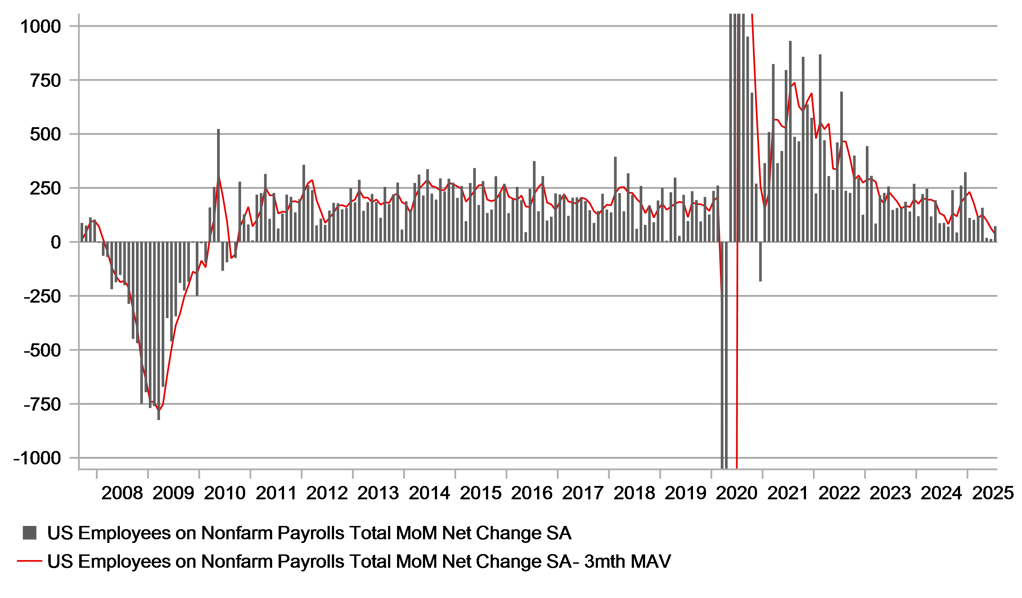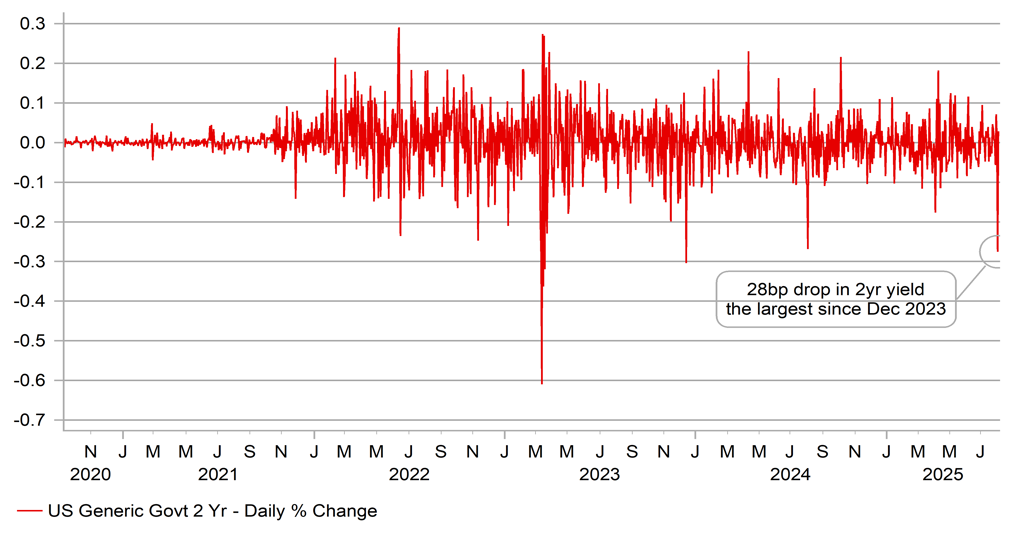US jobs data a gamechanger with Trump tariff policy likely questioned
USD: Jobs deterioration a gamechanger
The US dollar plunged on Friday and for good reason – the chance of a Fed rate cut dramatically shifted on Friday and we are now suddenly more in a position of needing data to stop the Fed from cutting rather than needing data to endorse a cut. The 28bp drop in the 2-year UST note yield was 1bp larger than in August 2024, coincidentally that move also triggered by a weaker than expected jobs report. The US dollar was at stronger levels a year ago but nonetheless that weak payrolls print triggered a bad month for the dollar, which weakened 3.8% through to 27th August. The yield drop on Friday was in fact the largest since the day of the FOMC meeting in December 2023 when there was a notable dovish shift from the Fed, signalling the prospect of monetary easing ahead. From the day of the FOMC and the 2-year yield drop, the dollar weakened by 2.8% through to the end of the year.
So certainly those moves highlight where the risks are skewed in relation to the US dollar over the coming weeks of potentially quieter summer trading and lower volumes. A big difference though is that the dollar is now at weaker levels than on those two previous occasions and the dollar fell by 10% in the first half of the year, the largest drop since 1973. That certainly reduces the prospect of a similar scale of move on this occasion.
However, it is easy enough to make the case that the fundamental news that triggered this drop in yields is potentially more significant. The Fed has come in for criticism and none more than from President Trump, who called Fed Chair Powell a “stubborn moron” before the data and called on the board to “assume control” if he refuses to cut. The firing of the head of the BLS further intensifies concerns over government influence into areas that should be independent. The data revisions were near unprecedented and only happen during periods of economic shock. The 258k downward revision happened last during covid and then before then during the GFC. The underlying picture has turned dramatically due to the revisions with the 3mth average at just 35k. The 3mth average to April was 127k. The non-cyclical private sector (excl education & health) recorded job losses of 49k over the three months to July. While there have been episodes of declines more recently, historically this is a development only for economic crises.
The ISM manufacturing employment index, also released on Friday, didn’t help ease fears over the economy with the index dropping sharply to 43.4, the lowest reading since and before that since the GFC.
One consequence of the data on Friday is the potential for the FX market reaction to trade tariff developments could turn negative again. The dollar had started to strength in response to trade tariff uncertainties as investors grew less fearful of the economic impact given before Friday there had been limited evidence of negative economic implications. The stark contrast in the 3mth averages before Liberation Day and after does highlight the impact of the uncertainty that could see last week’s confirmed tariff rates being viewed differently by investors. We always believed there was a degree of complacency and unjustified optimism in relation to the tariff impact on the US economy and the jobs data on Friday could alter that view dramatically. Our latest FX Outlook (here) released on Friday conveys our continued view of dollar depreciation, assuming the DXY declines by a further 6.2% by mid-2026.
NONFARM PAYROLL DECLINE POINTING AT RISING RECESSIONARY RISK

Source: Bloomberg, Macrobond & MUFG GMR
USD: Yields rebound as Kugler steps down
The 2-year UST note yield has rebounded from the huge drop on Friday, but only by 2-3bps with much of the official rhetoric following Friday’s data suggesting the Fed’s wait-and-see approach remains intact. New York Fed President Williams described the jobs market as “solid” but added that there was definitely a “slowing of jobs growth”. Cleveland Fed President Hammack and Atlanta Fed President Bostic were more upbeat as well. Bostic stated that while the data showed a greater slowdown than expected, he didn’t believe he would have changed his decision last Wednesday if he had known the data. Hammack in her comments focused on the balance between the two goals and repeated her view that inflation was expected to pick up. Minneapolis Fed President Kashkari stated that the labour market was “slowing gently”. So overall, the communications conveyed a sense of push-back to the view that a September rate cut is a done deal. However, push-back is what you would expect in the immediate aftermath and there remains another NFP report and two CPI reports before the FOMC in September so Friday’s adjustment in rate expectations is certainly enough for now.
The decision of Fed Governor Kugler to resign certainly adds another layer of uncertainty to the outlook for monetary policy. President Trump yesterday stated that he would “probably” announce a new Governor in the “next few days”. The shock firing of the head of the BLS due to Friday’s weak report is an obvious dangerous development and could harden the views of the FOMC to ensure its independence is protected. The new appointee will be just one vote on the FOMC and depending on who that person is, it could help shape the views of others in relation to a threat to its independence. Trump has also suggested the Kugler resignation reflects her views of Powell’s stance although there is no evidence of that in voting or communications. Her last comment on monetary policy on 17th July included a view that it was “appropriate to hold rates steady for some time”.
The usual names are being cited as possible replacements. We would view Kevin Hassett as the worst pick for the US dollar given his close association with the President. Scott Bessent, again by association, would also be ultimately viewed as negative but less so than Hassett with Kevin Warsh, Christopher Waller and Michelle Bowman all with Fed experience viewed more positively. Until we get an announcement, the appetite for buying back the dollar after Friday’s fall will be limited.
2YR YIELD PLUNGE OF HISTORIC MAGNITUDE WITH AN FOMC CUT IN SEPTEMBER NOW AN 80% PROBABILITY

Source: White House; 31st July 2025
KEY RELEASES AND EVENTS
|
Country |
BST |
Indicator/Event |
Period |
Consensus |
Previous |
Mkt Moving |
|
EC |
09:30 |
Sentix Investor Confidence |
Aug |
6.2 |
4.5 |
! |
|
US |
15:00 |
CB Employment Trends Index |
Jul |
-- |
107.83 |
! |
|
US |
15:00 |
Durables Excluding Defense (MoM) |
Jun |
-9.4% |
15.5% |
! |
|
US |
15:00 |
Durables Excluding Transport (MoM) |
Jun |
-- |
0.2% |
! |
|
US |
15:00 |
Factory Orders (MoM) |
Jun |
-4.9% |
8.2% |
!! |
|
US |
15:00 |
Factory orders ex transportation (MoM) |
Jun |
-- |
0.2% |
! |
|
US |
16:30 |
3-Month Bill Auction |
-- |
-- |
4.235% |
! |
|
US |
16:30 |
6-Month Bill Auction |
-- |
-- |
4.120% |
! |
|
US |
19:00 |
Loan Officer Survey |
-- |
-- |
-- |
! |
Source: Bloomberg & Investing.com
